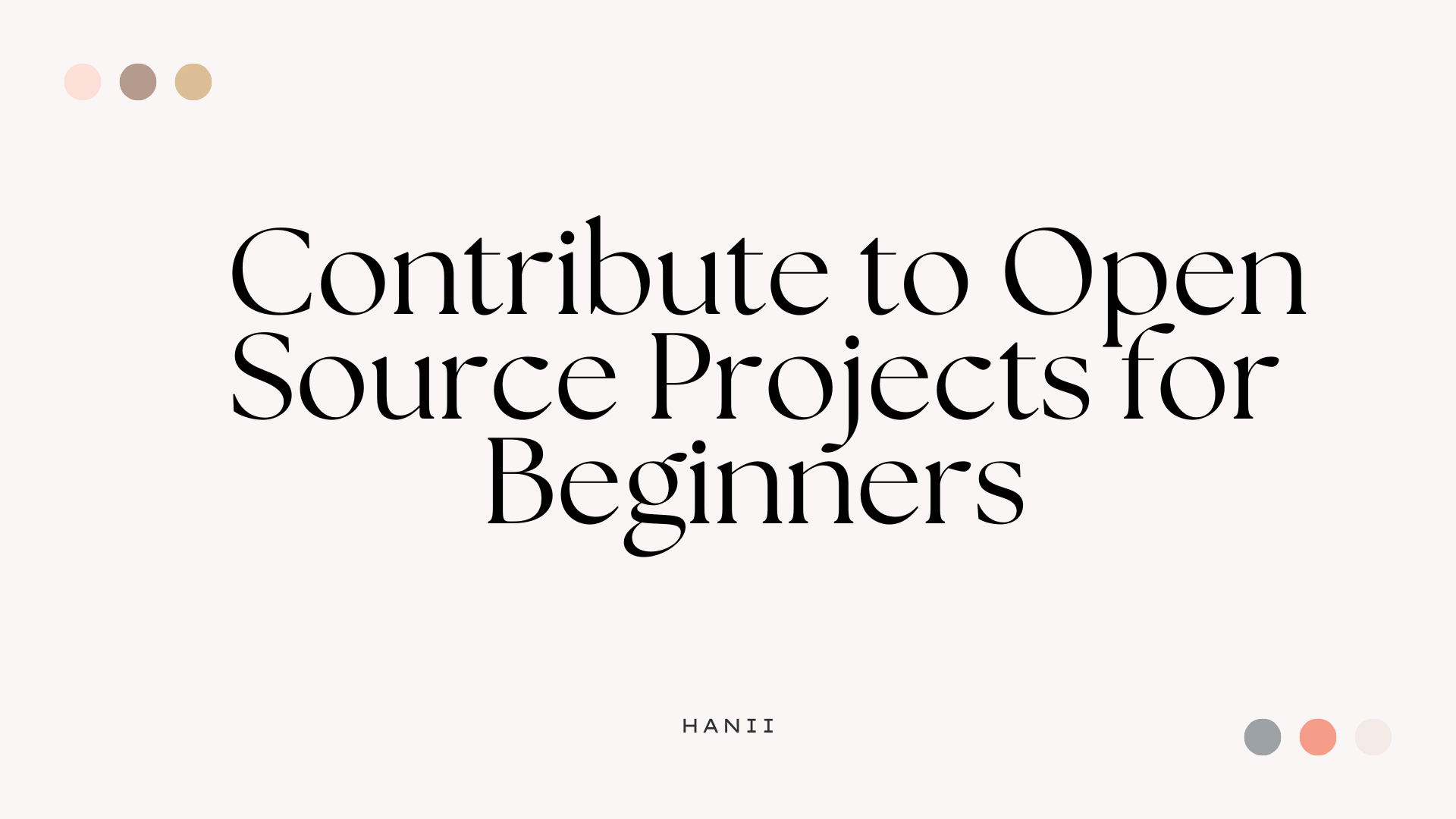Beginners' Guide to Contributing in Open Source Projects
 Hanii
Hanii
Introduction
Open source software (OSS) is intimidating to get involved with as a newer developer but so rewarding once you do. Beginners have a hard time getting started because projects are complex with problems and code that are difficult to understand let alone add to. It might feel hard to find ways to contribute when you're new or have less experience with large codebases. Despite being new, there are still many ways to get active in open source with any skill level. In this article, you'll learn the basics about open-source software to start contributing today.
What is Open Source?
Open source software is any software that allows the public to edit, modify, and improve the codebase. This is made possible by developers that contribute via improving code quality, bug fixes, performance, documentation, and community awareness.
Open Source Licensing
Projects that are open-sourced use different licenses to denote the level of freedom and restrictions a user of the code inherits. Licenses are a legal contract between the user and the author of the code for what a user can and cannot do with the technology. There are many types of open source licenses such as MIT or GNU General Public License that place different rules on a project. It is always important to know what type of license the project falls under so you are aware of your rights as a developer or user of the source code. (Note: you can learn more about open-source licenses in this article)
Stakeholders of Open Source
Open source projects have a few different types of members that influence and improve the source code. These people can be typically classified in the following roles:
Author: Whoever created the repository. This can be an individual developer or an organization.
Owner: Whoever has administrative access to the repository.
Maintainers: Contributors that drive the repository's goals by assessing discussions, pull requests, and issues.
Contributors: People that help add value to a project through coding and non-coding methods.
Community Members: People that actively use the project and give feedback to the project.
Anatomy of an Open-Source Project
Open-source projects come in all shapes and sizes with many sharing the same overall structure for collaboration. Projects often contain the following documents to better onboard new contributors and state the project's governance. Here are common files found across open-source projects:
README: The file that explains the project's purpose and how new members can use the project.
LICENSE: The license that allows others to contribute under certain guidelines.
CONTRIBUTING: The file that explains what areas of the project need contributions and the process to contribute.
CODE_OF_CONDUCT: The guidelines of how community members should conduct themselves to cultivate a welcoming environment.
Benefits of Open Source contributions
Contributing to open source adds value to every stakeholder invested in a project. Organizations, developers, and the customers they serve all benefit from an active open-source project. This section will go more into the benefits for us as developers rather than the other stakeholders. If you like to know more about the business case, Tobe Langel does an excellent job stating the benefits of businesses contributing to open source.
Better Source Code
Through contributing to open source, a project's quality improves and makes lives better for those that use it. This can be through bug and documentation fixes, listing examples, and feature requests. The better quality adds more value for stakeholders to invest in and use that open-source project.
Learn Best Practices
A beginner will pick up new coding skills by viewing and contributing to open-source projects. With early software knowledge, simply reading the code brings awareness to industry standards that beginners can learn. Developers can see examples of good coding techniques in projects and start implementing them in their work. This gives beginners a better idea of code etiquette and standards that help transform them into more knowledgeable developers.
Connect with Community
Being part of an open-source community offers the chance to grow, network, and mentor/be mentored. You can mutually exchange knowledge that benefits you and your connections as developers. It's also rewarding to connect with developers of all walks of life that can be your support network throughout your tech journey. By connecting, this developer community sees first-hand your skills and can bring opportunities straight to you.
Build Your Reputation
The job hunt is fierce for new developers and open-source contributions provide a public track record of your ability as a developer. Your ability as an employable developer is shown not only through your core skills, but also your soft skills. Working on open source is like being part of a giant team. Even if your contributions seem small, they demonstrate your ability to work and communicate on a team. Putting yourself out there in open source gives you a public space to display the skills necessary to get a developer job.
Ways to Contribute to Open Source
There are many ways to add value to open-source projects that you can even new developers can do. The following section covers some methods to contribute in brief detail. I have compiled a list of extra resources at the end of this article that can provide more substantial descriptions and examples of how each method is done.
Submit an Issue
You can use issues to start discussions on bugs, feature requests, documentation improvements, and other enhancements. You can ensure contributors and community members are aware of these ideas or problems by submitting an issue. Before submitting, it's best to check if someone else has already started that conversation. If that issue hasn't been done, you can create one that helps maintainers diagnose and solve the problem.
Do a Pull Request
You can solve known issues or problems found by yourself using pull requests (PR). Pull requests are the method you can contribute your own code to an open-source repository safely without overriding the main branch. By placing changes in a PR, the maintainers and other contributors can view the code, make comments, and changes necessary before your code is added. When contributing through a PR, the process works like this:
Fork the Repository: Make a copy of the repository and clone it to your device. Now you will have a version of the code to play with.
Create a Branch: Make a new branch with a name that references issues you are working on or explains the change you want to do.
Make the Changes: Work on the new additions or improvements in your branch and test them when possible.
Create the Pull Request: Make sure you highlight the differences in your changes so maintainers better know your contribution's impact. Hopefully, the maintainers approve of your code, and tada! You've contributed code to open source 🥳🥳🥳!
Non-Coding Contributions
Directly coding isn't the only way to help an open-source project. Developers can contribute just by spreading project awareness and creating opportunities to support the project. Here are just some of the many ways you can contribute without coding:
Write content that raises awareness of the project.
Help set up meetups or social channels.
Help create merch or other methods for funding.
Sponsor the project.
Help organize the project.
Help with the project's visual design.
Answer community questions about the project.
Contribute ideas to Github Discussions.
Addition resources
Many developers and organizations involved in the open source space have better described the topics in this article in greater detail. Here is a living list of resources to supplement your open source journey: (Note: This section will be updated to provide newly suggested or discovered resources to better educate new developers. Feel free to suggest resources that have helped you in open source)
Open Source Guides: Website full of guides relating to open source.
A Business Case for Open Source – Why You Should Contribute to the Open Source Community
Eddie Jaoude: GitHub Star, Youtuber, and Experienced Open Source Freelancer.
How to Get Started in Open Source by WebDevSimplified.
How to Contribute to Open Source Repo by FreeCodeCamp.
Wrapping Up
After reading this guide, I hope you have enough info to confidently dive into the open source world and widely expand your developer knowledge. If you are looking for places to start contributing, you can start at Up For Grabs, a website that lists projects with good first issues. Looking at projects you use is also a great start to contribute.
Subscribe to my newsletter
Read articles from Hanii directly inside your inbox. Subscribe to the newsletter, and don't miss out.
Written by

Hanii
Hanii
I'm a teacher. I have written the code that you've used. I speak, code, write, empower, promote, braid, learn, and listen - usually not in that order.